

To get the internal volume in (Cubic Feet or Liters) of the cabinet you have to make an estimation of the volume of the drivers, and subtract it from the total internal volume of the cabinet. The cabinet volume, and the desired resonance frequency determine the port diameter and length. Where < is the best symbol I can come up with for the speaker drivers.Īssuming you are using a bass reflex or ported/vented cabinet, the cabinet is tuned as a separate item. To calculate a 3-way, you simply calculate a 2-way at 800hz (as an example) and a 2-way at 5khz, and arrange them like this. In your case, you likely want a 3-way 12db/Second Order Linkwitz-Riley. Though again, your speakers are pretty close. The L-Pad need to be made up of non-inductive power resistor, minimum 10w on the tweeter and 20w on the woofer. In you case, all are very close, and you might get by without the L-PADs. Here is a link to a crossover calculator, which also has, near the bottom, a L-PAD calculator to attenuate the mid and tweeter down to the level of the woofer.Ĭrossover Design Chart and Inductance vs. And in a perfect, but far less likely world, below 40hz. Ideally you would like that to be down below 50hz. If these are the front speakers for a 5.1 Surround system, they are probably OK, but for a stereo system, a 70hz low end is very lean.

All well within the working range of your speakers. If we cross at 500hz instead, one octave is 1000hz, two octaves up is 2000hz, and the third octave takes us to 4khz. Well above the resonance and the rated low end of your tweeter. That is pretty high and most will move it down in the 4khz to 5khz range. So, if we crossover at 800hz, two octaves up would be 6400hz. Next, though not hard and fast, it is nice for the Midrange to span 3 octaves. Again, in this case, that is not likely to be a problem. The same is true of the tweeter, it has a resonance frequency (fs), and ideally you want to cross 2 octaves or higher. Agian, I'm assuming the numbers to illustrate the principle. So, if we assume the Mid driver has a resonance frequency of 100hz, then we would want to cross over at 400hz or higher. Which mean occasionally 500hz and more often 800hz.īut another issue comes into play, when you crossover to the midrange, you want that crossover to be ideally two octaves above the resonance frequency of your Mid driver. The peak power band in the low frequency is between about 250hz and 500hz, so most will cross over the speaker just above that power band.

Few woofer will go over 1khz very smoothly, though a few can be considered functional up to about 2khz. Next, you can certainly trust the low frequency specification on your woofer, but not the high frequency. Given the span of your Midrange driver can I assume it is a cone type speaker?


 0 kommentar(er)
0 kommentar(er)
